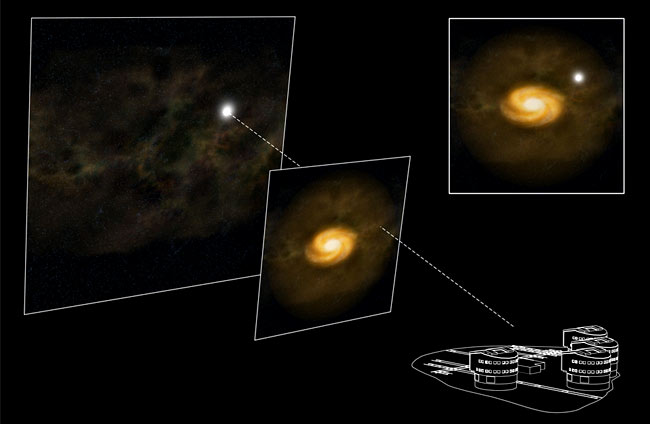Hidden Galaxies Detected

Deer can'tsee cars at night because of blindingly bright headlights. And until now,astronomers couldn't see foreground galaxies outshined by the dazzling quasarsbehind them.
A new techniquecan pick apart the intense pattern of light emitted by quasars, findingirregularities in the image where "invisible" galaxies are absorbingsome of the quasar light.
"Thedifficulty in actually spotting and seeing these galaxies stems from the factthat the glare of the quasar is too strong compared to the dim light of thegalaxy," said Nicholas Bouche, an astronomer at the Max Planck Institutefor Extraterrestrial Physics in Munich, Germany.
Bouche andhis team's findings will be detailed in an upcoming issue of AstrophysicalJournal.
Verylarge help
Quasars aresmall, distant and extremely bright cosmicbeacons that produce more light than typically comes from an entire largegalaxy. In spite of their brightness, however, some of the light is soaked upby intervening objects during its long journey to Earth's telescopes.
To locatethe so-called "invisible" galaxies, Bouche and his team lookedthrough huge catalogues of quasar data and picked out those with"dips" in their light signatures. Then, using the European SouthernObservatory's (ESO) Very Large Telescope (VLT), located in the mountains ofnorthern Chile, the team searched for galaxies close to the pulse of quasarlight.
Get the Space.com Newsletter
Breaking space news, the latest updates on rocket launches, skywatching events and more!
Theastronomers capitalized on the VLT's special infrared spectrometer, calledSINFONI, to pick apart 20 patches of sky around the quasars to search forgalaxies from the time when the universe was about 6 billion years old, almosthalf its current age. Seventy percent of the time, they found a galaxy hidingin the "headlights"of a quasar.
So far, theastronomers who pioneered the technique have detected 14 hidden galaxies bytargeting the VLT on unusual quasar light signatures.
Galaxyhunt
Bouche saidhe is surprised by not only the amount of galaxies he and his colleagues havefound hiding near quasars,but also by the types of these galaxies.
"Theseare not just ordinary galaxies," he said. "They are ? activelyforming a lot of new stars and qualifying as 'starburst galaxies.'"
These typesof galaxies are forming the equivalent of about "20 suns per year,"noted team member Celine Peroux, an astronomer at the Institute of Astronomy in Cambridge.
The teamthinks their finding will spur a new hunt for galaxies in the universe.
- Top 10 Strangest Things in Space
- IMAGE: Quintuplicate Quasar
- VIDEO: Quasar Interactions
Join our Space Forums to keep talking space on the latest missions, night sky and more! And if you have a news tip, correction or comment, let us know at: community@space.com.
Dave Mosher is currently a public relations executive at AST SpaceMobile, which aims to bring mobile broadband internet access to the half of humanity that currently lacks it. Before joining AST SpaceMobile, he was a senior correspondent at Insider and the online director at Popular Science. He has written for several news outlets in addition to Live Science and Space.com, including: Wired.com, National Geographic News, Scientific American, Simons Foundation and Discover Magazine.












